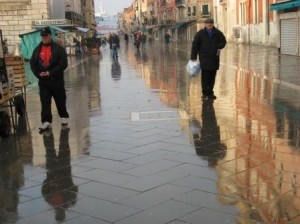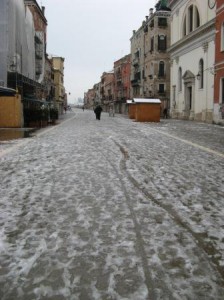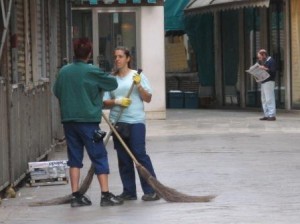That tenor with the Kevlar lungs has no trouble getting your attention. But what may be a little harder to imagine is how beautiful Venice sounds when left to her own devices.
Nothing against sight; of all the senses, sight comes first, at least for us humans. But sight can make you lazy, especially in Venice. All you have to do is open just one eye, even squinting, and you’d still see enough beauty to keep you going for months. Which led me to believe, for quite a long time, that being blind in Venice would be the worst thing in the world. I mean, if you had to be blind, you might as well go live somewhere else. Bland, Missouri. Oil Trough, Arkansas. Anywhere but here.
Venice in fact is doomed to be stared at, posing for a million of the same photos every day, a life as predictable and monotonous as the typical gondolier’s. So it’s easy to assume that it’s your eyes that you need most.
I don’t think so anymore. Here is how Venice sounds to me.

I sometimes wonder whether anybody out on the street bothers to consider that there might be people — us, for example — behind our Venetian blinds. But even if they did, I don’t think they’d care. The street by our window is like Andorra, a zone free of duty — any sort of duty, like not shouting after midnight. Public space here isn’t understood to belong to all of us. It’s understood to belong to none of us, nobody at all. Do whatever you want.
But there comes a mystic moment somewhere in the night when a silence suffuses the city that is almost more beautiful than Bach. Deep. Intricate. Voluptuous. It’s not merely the absence of noise, this silence is an element entirely its own, made of everything alive but inaudible, the tide turning and the breeze that begins to waft from the sea and the luminous darkness itself. The proto-morning is filled with a silence that could be the distillation of every sound in the world that we can’t hear.
Blackbirds. Just as I wait for certain flavors to appear in season, I wait for certain sounds, and beginning in March and going on till around now, the blackbirds announce the dawn with an accuracy a chronometer could only dream of. In fact, I know it’s 4:00 AM as I lie there in the dark because one blackbird will begin to sing. One. A single voice that’s like a flute that wants to be a crystal bell. It’s almost more beautiful than laughter. It is so beautiful that I challenge you to suggest a song that could even come close. It hasn’t been written. And as long as there are blackbirds on earth, I really don’t care. Too bad they got such a boring name, but I suppose calling them the “voice of angels” bird would sound worse.
A shutter opening (or closing).
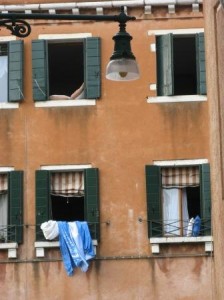
For me, this is one of the quintessential sounds of Venice, even more than foghorns or the bells of San Marco, God forgive me. It is one of the elemental sounds of dawn, an intimate, homely scraping noise ( it depends on how old and how plumb the shutters are) followed by two clunks as the shutters reach the outer wall. It’s the domestic equivalent of the trumpet at Churchill Downs.
Shutters are no mere decoration; Venetians believe — sorry, they know — that drafts are the thin end of the health wedge. Anything from a head cold to pleurisy, hiccups, the blind staggers, whatever you’ve got will almost certainly have been caused by a draft that was carelessly permitted to enter. “Colpo di finestra, colpo di balestra,” they darkly say: “A blow (as in punch) via the window is a blow from the crossbow.” No doubts, no discussions. If you don’t close your shutters, you’re just asking for it.
Rolling suitcases, all sizes, from carry-ons to steamer trunks. This is a fairly new sound which — unlike the birds and the shutters and all — the Venetians of yore might have trouble identifying. Considering how tourist apartment rentals have proliferated all over the city, the suitcase-sound has become as irrevocable as the sunrise. I will hear it as early as 3:00 AM, if the hardy travelers are trying to make the first flight at 6:35 sharp. (Unlikely, as that plane is going to Lyon, but they’ll almost certainly want one of the following flock of early flights to Rome, Frankfurt, Amsterdam, and all those other big connection points for intercontinental flights).
Your average rolling suitcase isn’t any happier to be up at this hour than its people are, because it makes a heavy low grumbling noise as it is dragged along the granite streets. Then it goes bumpbumpbump twelve times, up the steps of the bridge. And twelve bumps down the other side.
Until a few years ago, the only hotel in this precinct was a modest if overpriced former palazzo with guests who traveled at decent hours. But now there has been an explosion of little bijou hotels which call themselves “bed and breakfast” but which have no relation whatever to the classic British version I remember so fondly (a spare room in some little retired couple’s house). There has been an even greater efflorescence of apartments for rent; if you start noodling around on the Net, you might think there is no dwelling left for Venetians, a feeling which many Venetians have begun to share.
So with all these places to stay, about ten to fifty times more people are hauling their stuff around today than even two years ago. The second-floor apartment across the street from us — all of ten feet away — belongs to someone who rents it through a French agency, because only French people stay there. They annoy the hoo out of the Venetians who live in the building, because they forget to close the front door, or they put their garbage out at inappropriate times (“Well we’re leaving before the trash is collected tomorrow,” one woman told me huffily, and I had to admit she had a point). And they toss their cigarette butts out the window. I never see them do it, but I also don’t see any excuse for it. Every few days I go out and sweep up all the cruddy filters strewn between their door and ours. (Filters — strange, I know. They don’t make French smokers the way they used to. Next thing you know, they’ll be drinking Coke. Oh wait — 42 percent of the French population does drink Coke. Well there you are.)
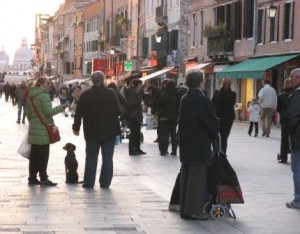
The sounds that shape the rest of the day depend on weather, whether or not school is in session (parents and children chattering on their way home), when the shops close (usually between 12:30 and 1:00) which means clumps of women form at the foot of the bridge to finish whatever it was they were discussing). It also depends on whether or not the kids have had their naps, or snacks, or have been thwarted in some way as their blood sugar plummets. Between 5:00 and 6:00 it seems that every toddler in the neighborhood collectively snaps, because what I used to think of quaintly as the “aperitivo hour” I have now re-labeled as the Hour of the Imploding Child.
The invisible piano. This is my favorite summer sound. I’ll hear it in the early evening, wafting out of an upper-storey apartment at the foot of via Garibaldi, behind some trees. It’s obviously a person and not a recording because of repetitions and occasional errors, and whoever it is (man? woman? no way to guess) plays well enough for it to be enjoyable but not so well as to be off-putting. Chopin ballades, sonatas by Scarlatti, “Invitation to the Dance” by Weber, music my mother used to play after supper. It makes me feel happy.

Foghorns. My favorite winter sound. There are a few unpleasant aspects to fog, of course — clothes on the line which have given up all hope of ever drying; vaporettos re-routed up the Grand Canal for safety reasons, which drastically distorts your route to wherever you need to go. People not from Venice think that high water is a nuisance, but they’ve never seen what fog can do to your day. Hordes of tired, hungry, harassed people accumulating on the dock at Sant’ Elena waiting for the vaporetto with the radar to finally arrive and take them the five minutes across to the Lido. No radar, no vaporetto. Boats used to make this little crossing all the time, now you’d think that they were facing the iceberg zone off Greenland or something.
But when I hear the distant foghorn, it carries more romance to me than 289 gondola rides — or even one, actually — under the Bridge of Sighs. The occasional deeper blast from the Minoan Lines ferry arriving from Greece — warning? threat? — is also exciting, especially if you’re out rowing in the fog and it’s blowing at you. This has happened to me.
Bells. The bells in the campanile of San Marco ring several times a day, but I pay special attention to certain ringing. Such as the single bell that sounds at 3:00 PM every Friday, to recall our thoughts to Good Friday and the crucifixion of Christ. There is the midnight tolling of the marangon, the deepest of all, which you can hear from many parts of the city. Depending on which way the wind is blowing, I’ve even heard it when we were out in the lagoon. Deeply comforting, like the sentinel on the battlements. The bells also ring every July 14 at 10:02 in the morning, to commemorate the epochal collapse of the campanile at that moment in 1902.
But with the dark that sumptuous stillness (eventually) returns, permeated not only with the voices of forgotten doges but also the voices of exasperated mothers and Macedonian plasterers.
Of course it would be terrible to be blind in Venice. But it would be at least as bad to be deaf here.


